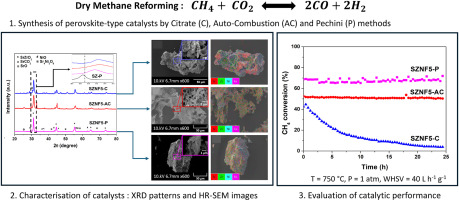Ask for a reprint
email :
* Give your email
2024
ACL
|
Faicel Belgacem, Raphaël Schneider, Jean-François Portha, Ghouti Medjahdi, Lavinia Balan, Ksenia Parkhomenko, Anne-Cécile Roger, Laurent Falk, 'Influence of perovskite catalysts synthesis methods: Application to dry methane reforming', Int. J. Hydrog. Energy 91 977-988 (2024) doi:10.1016/j.ijhydene.2024.10.119
Perovskites refer to ceramic materials with an ABO3 structure. The optimization of synthesis parameters and material composition can enhance the catalytic efficiency in various chemical reactions, such as dry methane reforming. In order to highlight the differences in the catalytic properties, this study aims to compare three synthesis methods (citrate, auto-combustion and Pechini) for a same perovskite formulation namely SrZr0·5Ni0·4Fe0·1O3. The crystal structure and reducibility profile are determined by XRD and TPR experiences respectively. Surface properties and composition are identified by chemisorption tests (allowing the study of basicity and nickel dispersion) and XPS analyses, respectively. Isothermal catalytic experiences from 600 to 750 °C, under atmospheric pressure and for a WHSV of 40L/h.g together with stability tests for 25 h at 750 °C were conducted. The outcomes show the importance of properly choosing the perovskite preparation methods in order to achieve the desired surface, structural and reactivity properties.
|

|